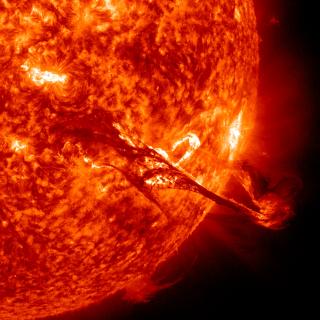Bibcode
González-Morales, P. A.; Khomenko, E.; Downes, T. P.; de Vicente, A.
Bibliographical reference
Astronomy and Astrophysics, Volume 615, id.A67, 14 pp.
Advertised on:
7
2018
Journal
Citations
35
Refereed citations
34
Description
The interaction of plasma with magnetic field in the partially ionised
solar atmosphere is frequently modelled via a single-fluid
approximation, which is valid for the case of a strongly coupled
collisional media, such as solar photosphere and low chromosphere. Under
the single-fluid formalism the main non-ideal effects are described by a
series of extra terms in the generalised induction equation and in the
energy conservation equation. These effects are: Ohmic diffusion,
ambipolar diffusion, the Hall effect, and the Biermann battery effect.
From the point of view of the numerical solution of the single-fluid
equations, when ambipolar diffusion or Hall effects dominate can
introduce severe restrictions on the integration time step and can
compromise the stability of the numerical scheme. In this paper we
introduce two numerical schemes to overcome those limitations. The first
of them is known as super time-stepping (STS) and it is designed to
overcome the limitations imposed when the ambipolar diffusion term is
dominant. The second scheme is called the Hall diffusion scheme (HDS)
and it is used when the Hall term becomes dominant. These two numerical
techniques can be used together by applying Strang operator splitting.
This paper describes the implementation of the STS and HDS schemes in
the single-fluid code MANCHA3D. The validation for each of these schemes
is provided by comparing the analytical solution with the numerical one
for a suite of numerical tests.
Related projects

Numerical Simulation of Astrophysical Processes
Numerical simulation through complex computer codes has been a fundamental tool in physics and technology research for decades. The rapid growth of computing capabilities, coupled with significant advances in numerical mathematics, has made this branch of research accessible to medium-sized research centers, bridging the gap between theoretical and
Daniel Elías
Nóbrega Siverio

Solar and Stellar Magnetism
Magnetic fields are at the base of star formation and stellar structure and evolution. When stars are born, magnetic fields brake the rotation during the collapse of the mollecular cloud. In the end of the life of a star, magnetic fields can play a key role in the form of the strong winds that lead to the last stages of stellar evolution. During
Tobías
Felipe García